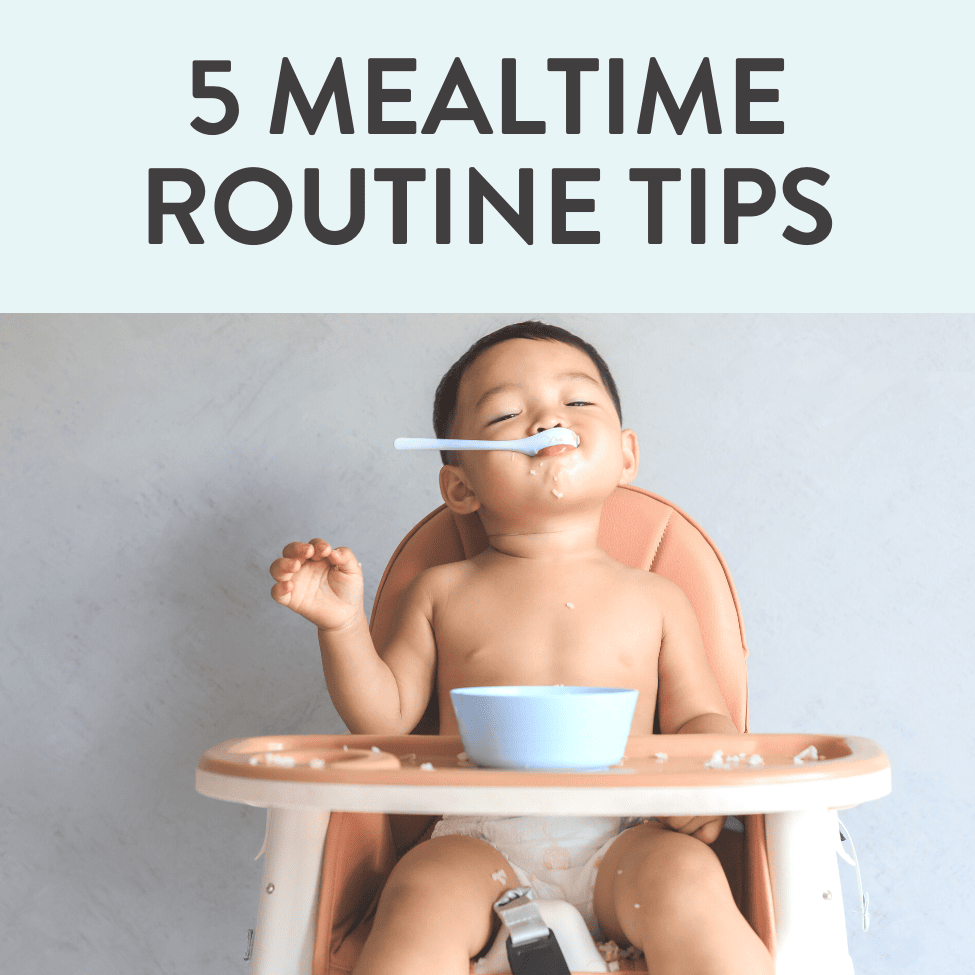Learn how to maximize your mealtime routines and help your baby learn to eat! We’ll share 5 of our top tips for creating positive meals for baby. (Psst – these tips also work well for toddlers and older kids!)
Medically reviewed and cowritten by Lauren Braaten, Pediatric Occupational Therapist (OT).
Meal Time Routine for Baby
You’ve probably put a lot of thought and effort into your baby’s sleep schedule. But have you ever considered the importance of your mealtime routines?
Having a consistent routine can help your baby know what to expect when it’s time for meals. When baby knows what’s expected, they feel calmer and more relaxed. And calm, relaxed eaters are more likely to be engaged in the meal and try new foods!
Fortunately, it’s never too late to set up a good mealtime routine – or make a few tweaks to your family’s current routine if you feel it isn’t serving you well. Let’s talk about 5 tips for creating a positive mealtime for your baby and your whole family.
Benefits of Mealtime Routines
Research has shown that children who have mealtime routines are more likely to eat a variety of foods and consume more fruits and veggies than those who don’t have a routine. Here are a few other benefits of setting up good routines:
- Physical development: Providing regular opportunities for eating gives your baby a chance to develop fine motor skills. Baby can practice using a pincer grasp to pick up small pieces of food. As they get older, they’ll practice using a spoon and fork. Older kids can practice skills such as using a knife to cut soft foods and pouring water from a pitcher, as these support fine motor control for activities like handwriting and shoe tying!
- Social skills: Baby can learn a great deal about social interactions just by being present at the dinner table – sharing food, social smiles, the give and take in conversation. Mealtimes allow older kids to practice using their manners and sharing about their day.
- Language development: Babies often learn many of their first words at mealtimes, such as ‘yes,’ ‘no,’ ‘more’ and ‘all done.’ Mealtimes are the perfect place for helping babies and toddlers build vocabulary skills and combine multiple words.
- Sensory Exploration: Regular mealtimes allow babies to use their fingers and hands (sometimes even their arms, legs, and hair!) to explore how foods look, feel, smell, and taste. Although things might get a little messy, it’s a great learning experience!
Frequently Asked Questions
The World Health Organization (WHO) recommends introducing nutritionally adequate and safe complementary (solid) foods at 6 months, although your baby may be ready slightly earlier or a little later than that, depending on their development. This Complete Guide to Baby Led Weaning can help you decide if your baby is ready to start eating solid foods.
Getting in the habit of sitting down with your baby during meals is a good idea for a few reasons: 1) it keeps you within arm’s reach of your baby for safety, should they choke on a food. 2) it gives your baby a chance to see you model eating different foods, and 3) it helps your baby learn that meals should be eaten sitting down, not on the go.
No, you don’t always have to eat the same thing baby eats (or even eat at all if you’re truly not hungry at that time); however, it’s still a good habit to be sitting near or within arm’s reach of your baby during meals, whenever possible.
First, try to problem solve – is baby truly hungry? Overly tired? Dirty diaper? As much as we try to encourage the importance of routines, sometimes you have to tweak your routine a bit and try again in 30-45 minutes. Keep making mealtimes positive, engaging, and aim for short amounts of time spent in the highchair to start (5-10 minutes).
Typical Eating Schedule for Baby
Although every baby’s journey to eating foods is unique, most babies are ready to start solid foods around six months of age, whether you’re using a baby-led weaning approach or spoon-feeding purees. You can start by offering 1 or 2 eating opportunities a day between breast or bottle feeds and slowly progress to 3 meals and 1-2 snacks from there. Ideally, this will be close to, or at the same time that the rest of the family is eating, but making a plan ahead of time for when you’ll offer foods can still be helpful.
Below is a sample schedule for 6-7 month olds. For more information on eating schedules and baby-led weaning tips, check out our Complete Guide to Baby-Led Weaning.
7am- 7:30-wake-up, bottle/breastfeed
7:30am-8:30am- play
8:30am-9am- breakfast of banana segments and/or spinach and cheese omelette strips
9am-10:30am- morning nap
10:30am-11am- bottle/breastfeed
11am-12pm-play
12pm-2pm- afternoon nap
2pm- 2:30pm-bottle/breastfeed
2:30-4pm- play
4pm-5pm- cat nap
5pm-5:30pm- bottle/breastfeed
5:30pm- 6:30 pm- play
6:30pm- bath
7pm-7:30pm- bottle/breastfeed
7:30pm-bedtime

Tips for Successful Mealtime Routines
There are many aspects come together to make successful mealtime routines, and these might vary slightly, depending on the child or family’s needs. Here are 5 of our top tricks and tips for setting up positive meals:
- Use simple cues for the beginning and the ending of each meal. This can be as simple as making sure your tv is turned off, putting on some calming music, and telling your baby it’s time to eat. The beginning and ending of meals are also great opportunities to practice baby sign language, such as “eat” and “all done”.
- Practice intuitive eating. Follow your baby’s cues and let your baby determine whether or not she wants to eat a portion of food and how much she wants to eat. Allowing your baby to develop and express feelings of both hunger and fullness will set them up for good eating habits later on in life. Many parents who decide to use baby-led weaning appreciate the intuitive aspect of this approach.
- Be engaged. Face your baby toward you or other family members and resist the urge to multi-task during mealtimes! When you are present and interactive with baby, they get to see you model how to bite and chew foods, they get to hear your talk about colors, shapes, sizes, smells of foods, AND they start to understand that mealtimes are a positive, interesting experience.
- Expect a mess (but try not to stress). When you first start feeding a baby, the amount of mess can seem overwhelming. Try to remember that this phase won’t last forever. Have a plan for making cleanup easier, such as bibs that double as “food catchers,” a large mat underneath the highchair as needed, and a good vacuum. After the meal, you can even take your baby directly to the sink to rinse their hands and face for easier cleaning.
- Give yourself some grace. We can have the best intentions in the world to serve a homemade dish for every meal your baby eats, but we all know that life happens. Sometimes we have to work late, sometimes you have to eat on the go, or sometimes you just don’t feel like making an effort. It’s all okay. Remind yourself that you are the best parent for your child and you’re doing your best in that moment.
Feeding Tips and Tricks
- Provide your baby or toddlers with a warm washcloth in their highchair or booster chair at the start of the meal. This gives them a fun way to participate in getting ready for the meal.
- Try to limit distractions during meals as much as possible – this might include shutting off or putting down any screens, putting nosy pets away in a different room, or even avoiding getting up and down from the table frequently during the meal.
- Sit your baby in a safe place, such as a highchair or booster seat and make sure they are buckled in securely.
- Mealtimes do not have to last a long time. Mealtimes can last 10-15 minutes or for as long as your baby appears engaged in eating.
- Discuss your goals and plan of action with your partner and any other caregivers so that your approaches are as consistent as they can be.


